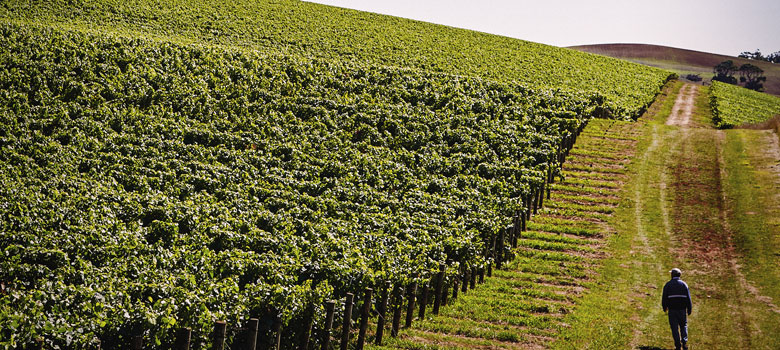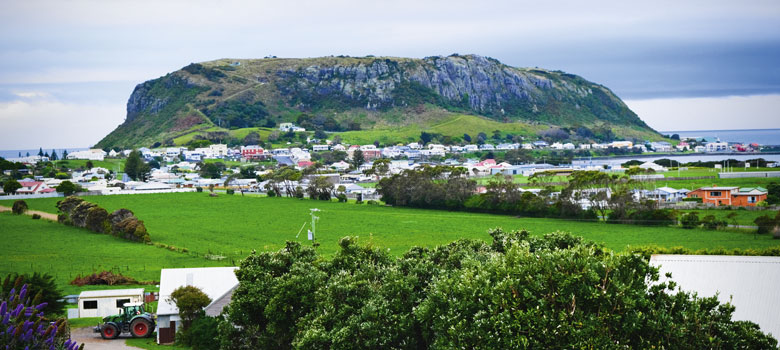
Life
Travelling Northern Tasmania and the Tamar River
While it’s rightly famous for its Pinot Noir and Chardonnay, these varieties are just two of North-west Tasmania’s many attractions.
Meg Culhane is a picture of strength, poise and grace as she adopts her warrior pose in the vineyard. Her supple arms follow the taut line of trellising, her legs mirror the trunks of the Pinot Noir and Chardonnay vines for which this region is so well known.
We are doing Yoga in the Vines at Josef Chromy. Well, some of us are. I’m here more for the comic relief – and the sparkling wine. And despite my lack of agility, balance and contortionist capabilities, these classes are lots of fun.
Over my left shoulder are typical Tasmanian wine country scenes – rolling hills, vineyards and lakes. A sea of green and blue. Over my right shoulder is the restaurant filled to the brim with diners no doubt amused that the vines are not the only old and gnarly things soaking up the sunshine.
Left: Sunlit beauty at Delamere. Right: The Joseph Chromy cellar door.
Just 10 minutes south of Launceston, Josef Chromy Wines is listed as one of the Top 10 Cellar Doors of Australia and it’s the first stop on a Tamar Valley trek.
More importantly, just 10 minutes from my yoga mat is lunch and a well-earned wine tasting.
It’s a ‘Fizz, Gris, Chardy and Pinot’ affair – NV Cuvee, Pinot Gris, Zdar Chardonnay and Pinot Noir.
And because of our hard work in the vines, we’re also treated to the 2016 Brut Finesse – the world’s best Chardonnay this year according to the International Wine and Spirit Show in Spain.
The only thing to match that is lunch – potato and kunzea risotto and applewood grilled lamb rump for me – prepared by chef Nick Raitt – a One Chef Hat winner in the Australian Good Food Guide every year since 2017.
Tamar Valley is Tassie’s oldest wine growing area, famous for its cool climate wines.
It stretches up either side of the Tamar River, which winds its way from Launceston north to Bass Strait.
This makes Launceston a good base for Tamar touring.
Left: Mrs Jones Resturant and Bar in Devonport. Right: Tasmanian Bridge.
Launnie, as the locals like to call it, is the largest city in the north-west and a hub for food, festivals and fun.
And the wilderness is right on your doorstep. Cataract Gorge is a backdrop to the city – a 20-minute walk from the CBD.
If you want to drive, it’s two minutes to the gardens, pool, cafe and footbridges where you can watch the wild South Esk river carve its way through dolerite cliffs.
A chairlift goes over the water to the Band Rotunda where you’ll meet peacocks, wallabies and maybe even Rex the resident echidna.
Put Stillwater, Grain of the Silos, Bluestone and Geronimo on the dining wishlist in Launnie; bar hop from Alchemy to Firestorm, Bar Two and Cinco; walk through City Park to see the monkeys and make time for the two-part Queen Victoria Museum and Art Gallery.
While you’re staying in Launceston, take a 20-minute drive south to call in on Simon and Frances Stewart at their winery Bell & Gong. While theirs is one of the state’s newest vineyards, it’s planted on one of Tasmania’s oldest properties, Valleyfield. Enjoy a tasting of their Pinot Noir, Sauvignon Blanc and Riesling, then take a walk through their sanctuary where you just might spot an Eastern Barred Bandicoot.
Where to stay in Launceston: Peppers Silo Hotel overlooking Riverbend Park where you can sleep in an old silo and Verge, right in the city and across the road from City Park.
Left: Sinapius Vineyard's Linda Morice. Right: Sinapius Resturant.
EAST TAMAR
You can tackle the Tamar in two ways – on a 170km driving loop which takes in about 23 cellar doors – or on day trips from Launceston.
We head east first.
Bay of Fires Wines at Piper River is our first stop – about an hour’s drive north west, past cherry orchards and berry farms and alongside huge forests.
Not to be confused with the Bay of Fires destination, this is said to be the coldest, dampest part of Tasmania and is home to House of Arras – a household name for bubbly fans and the work of Ed Carr, widely regarded as Australia’s pre-eminent sparkling winemaker.
Visitors sit down to a structured tasting starting with the best – the Blanc de Blancs, seven years in the making.
Sinapius is next, a family-owned 4.5 hectare vineyard known for high-density plantings and dry-grown vines on the rich red ferrosol soil.
“The vines are planted 1.1m apart,” says cellar door manager Kim Clayton. “The grapes compete for nutrients so we get low yield but high quality…smaller berries and more flavour.”
Everything is bottled, labelled and sold here, so you’ll have to visit to taste the knockout 2020 Jean Morice Rosé made from 100% Gamay.
Next door is Delamere and the chance to sit down with the ‘wine waffler’ Simon McInerney.
Shane Holloway and Fran Austin’s winery is in good hands with Simon, who imparts an enormous amount of information and passion over a casual chat and tasting.
Their focus is on bubbles with six on the tasting menu. We start by comparing a non-vintage and 2012 vintage Rosé (both lip-smackingly lovely), while Simon talks about the value of wine.
“The value of wine is not about price point,” he says. “Wine in the bottle is worth something, but the joy is in the drinking.”
As he pours a glass of Museum Release (2013) Chardonnay and a 2011 Pinot Noir, Simon touches on the need for wine deadlines.
“Check the ageing capacity of what you buy and stick to it,” he says. “Store it by years then it never goes off and never gets wasted.”
And his classic piece of advice: “I’ve never had a wine that doesn’t go with pizza.”
We stop at Pipers Brook for lunch and a self-guided tasting at Nadine’s Cafe. You can choose from Pipers Brook, Ninth Island, Pipers Tasmania and the Kreglinger Sparkling labels.
Then it’s back to Launceston via Jansz Wine Room and Dr Andrew Pirie’s two hectare sustainable vineyard, Apogee.
Left: Swinging Gate cellar Door. Right: Pipers Brook Resturant.
WEST TAMAR
Velo Wines is the first cellar door along the western side of the Tamar River with the ever-popular Timbre Kitchen restaurant next door, too irresistible to pass for a long lunch.
All dishes are made to share from the sumac and smoked paprika popcorn to cold-cut brisket, smoked onion and flatbread and miso caramel mousse with honeycomb.
With more time to spare, you could drop in to Tamar Ridge Wines, Loira Vines and Marion’s Vineyard at Deviot, but we are booked in for a Swinging Gate tasting. I’m keen for Pet Nat (petillant naturel) said to be the precursor to modern-day sparkling wine.
Nellie greets us with a cold nose and lick on the hand. She is the loveable winery dog. Next is Corrie Cox, owner and winemaker and her daughter Hannah. Doug – husband and viticulturist – is busy looking after the only Frontignac vines in the valley.
Like most wineries in the Tamar, Pinot Noir is their biggest seller, but Fronti runs a close second.
“Doug likes doing things differently,” says Hannah. “Fronti is a warm climate grape, so it’s not supposed to work here …but it does.
“We also have a Merlot Rosé and our Pinot Gris is left on skins so it’s pink.”
And then there’s Pet Nat – the cloudy sparkling wine that appears to have things growing in the bottle and which comes with a warning for how to open it.
“This wine is unfiltered so the CO2 binds to the sediment and can cause gushing,” the instructions warn. “Open very chilled and over a sink with your glass handy so you don’t lose a drop.”
Wise words.
If you want to stay longer, Swinging Gate has three glamping domes, run by Domescapes, that look out over the vineyards and come complete with outdoor baths on the deck.
Left: Stillwater - A dining must at Launceston. Right: Freshly picked grapes at Sinapius.
TASTING TRAIL
As well as the Tamar Valley Wine Trail, a road trip west from Launceston will take you along the 225km Cradle to Coast Tasting Trail.
Hide the scales and park the guilt for this journey. There are 37 stops dotted along the north-west coast to Smithton and Stanley – all with a backdrop of lush fields and coastal views.
Plus a few detours to places like Table Cape Tulip Farm and Cradle Mountain for good measure.
Brace yourself for wine, whisky, beer, cider, gin, coffee, icecream, olives, oysters, lobster, truffles, honey, chocolate, cheese, berries and hazelnuts.
At most stops you can taste and buy the products and see how they are grown, collected, fermented, processed and packaged.
And then there are the eateries like Timbre, Hurseys at Stanley Grazings at Guide Falls Farm, turning all that local produce into gourmet feasts.

The Nut at Stanley
GETTING THERE
Take advantage of new direct flights to Launceston from Perth, Adelaide, Melbourne, Sydney, Brisbane and the Gold Coast.
The Spirit of Tasmania ferry arrives in Devonport, 100 kilometres north of Launceston. The drive will take you along the western side of the Tamar River.
Devonport is worth exploring, especially the Bluff Beach area, Bass Strait Maritime Museum and Tasmanian Arboretum at nearby Eugenana.
Dine at Mrs Jones Restaurant and Bar Lounge (you’ll need to book) and stay at the Waterfront Complex apartments.